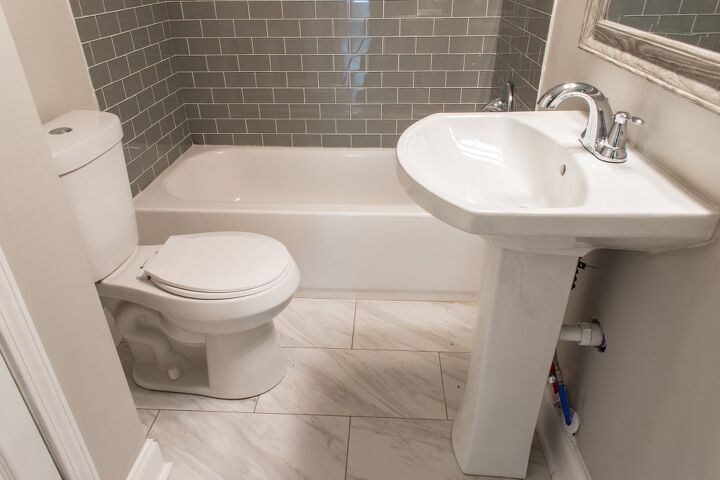Is A Heat Source Required In A Bathroom?

You may be adding a bath and bedroom addition to your home. Your plan may involve repurposing space in your home as an additional bathroom. A pending sale on your home may require a home inspection. Any of these may prompt a question about the need for a heat source in a bathroom.
According to the International Building Code, bathrooms are not considered habitable spaces and are not required to have a heat source. Section R303.8 of the IRC specifies the minimum heating requirements for habitable spaces. Under definitions, bathrooms, closets, hallways, and utility spaces are not considered habitable spaces. Local building codes should be checked before any project begins.
Remember that the IRC is a minimum standard for the most part. Heating in a bathroom should not be omitted because the IRC doesn’t require it. There are more important considerations than meeting the minimum standards of the International Building Code. Comfort, convenience, and safety are good reasons to install a heat source in a bathroom.
Do You Need a Heating and Cooling Contractor?
Get free, zero-commitment quotes from pro contractors near you.

If it is Not Required, Why Should I Put a Heat Source in a Bathroom?
In many instances, the answer to this question is more about common sense than codes and regulations. Several common-sense reasons for putting a heat source in a bathroom come to mind. There may also be circumstances when the extra expense is not warranted. Again, applying a bit of common sense to the situation can answer many questions.
Examining a few theoretical situations may give you insight into how common sense comes into play. Remember that these are not definitive answers. These scenarios represent some hypothetical situations and how we would apply a bit of common sense to arrive at a solution.
The Small Interior Powder Room
Many homes, especially those with two or more stories, have small powder rooms located on the first floor. It is usual for these spaces to have no exterior walls and minimal floor space. Unless the local building code specifies otherwise, this space does not need a heat source. Common sense tells us that the space will probably maintain almost the same temperature as the rest of the home without an HVAC vent or auxiliary heating.
Adding an HVAC vent or an auxiliary heater would, in our opinion, be an unjustified expense. Unless the homeowner specifically requests heating in this space, it is a good bet that it won’t be required to maintain a comfortable temperature even in the coldest winters.
An Average Size Ensuite Master Bath
The popularity of ensuite master bathrooms is without question. Most of these ensuite bathrooms have an exterior wall exposure. Many ensuite master bathrooms include a window to allow light and fresh air into the bathroom as desired. These ensuite facilities may have a minimum footprint or include almost as much square footage as the master bedroom they serve.
Under these circumstances, most HVAC contractors would install a heat register in the bathroom as a matter of course. Even an ensuite bathroom with minimal square footage benefits from having a heat source. The exterior exposure and, possibly, a window are two good arguments for adding a heat source to this space.
Ensuite bathrooms that were once considered luxuries are now considered by many a necessity. No one wants to leave a warm bed only to enter a cold space during the night or in the morning to take a shower. Having that heat source in the ensuite bathroom ensures that the space is comfortable and inviting.
Luxury Spa Style Bathrooms
Many new upscale homes include large spa-style bathrooms. These spa-style bathrooms may include separate toilet spaces, elaborate walk-in showers, Jacuzzi-style tubs, and other amenities. Some may even have saunas installed. Often, these amenities are enclosed in spaces whose size rivals the largest bedrooms in the house.
It makes good sense that a space that can approach the size of other living spaces in the home needs to have heating and cooling. The International Business Code may not consider these spaces as habitable areas. Common sense tells us differently. These types of bathrooms are often focal points for the homeowner. As such, these spaces deserve all of the amenities any other space would receive.
What Are The Options for Heating a Bathroom?
We are far past the open flame bathroom heater common in the 1950s and 1960s. Now outlawed, these types of heaters were once very popular. Technology has provided an array of different options for heating a bathroom space. These options are available for new construction or retrofit applications in an existing bathroom.
New options for bathroom heating are being introduced to the market regularly. We suggest that you consult with a professional HVAC installer. These professionals are abreast of the latest trends and options for heating and cooling and can recommend the best options for your situation and your bathroom.
Electric Wall Heaters
Electric heaters can provide a relatively cost-effective solution for small bathroom spaces. These electric heaters mount into the stud space in the bathroom wall. Because there is no open flame involved, no exterior vent is required. Many of these units have fans to help circulate the heated air in the bathroom.
Electric wall heaters may not be viable for large bathroom spaces. The installation of these units often involves running a dedicated electrical circuit to the heater. Generally, this requires a licensed electrician and a building permit to complete the installation.
Combination Vent Fan and Heat Lamp
Another relatively inexpensive option is the combination heat lamp and exhaust fan. Many times, a combo unit of this type can be retrofitted into the space used by a regular exhaust fan. Heat lamps employ infrared technology to provide heat into the living space.
However, there are several downsides to these combo heat and exhaust fan units. An additional dedicated electrical circuit must be installed to supply the high wattage heat lamps. This can involve getting a building permit and usually requires the services of a licensed electrician.
These heat lamps also provide only limited heat into a room. Most of the heat is delivered downward as infrared rays and heat only the space directly beneath the lamp. While these units a relatively cheap to purchase and easy to install, the amount of warmth they deliver is minimal, and their efficiency is less than optimal.
Radiant Floor Heating
Radiant floor heating is gaining in popularity for bathroom heating. No one enjoys stepping from a warm carpet onto cold floor tile in a bathroom. Radiant floor heating overcomes this by delivering the warmth upward through the floor covering and into the room. It is easy to understand the attraction of underfloor heating, especially in very cold climates.
Installing underfloor radiant heating requires removing the existing floor covering to install the heating elements. The heating elements are installed in new construction before the floor coverings are applied. This makes installing radiant underfloor heating more cost-effective in new construction.
Generally, a new electric circuit is required to be installed with the underfloor radiant heating elements. The controls for the radiant heat are located on a wall near the other electrical controls in the bathroom. These systems are safe, efficient, and effective.
Existing HVAC System Duct
It is not uncommon to find a traditional HVAC duct installed in a bathroom. This installation is very efficient, where central heat and refrigerated air conditions are common. If your house has an existing HVAC system, it may be possible to tap into the ductwork and install an outlet in your bathroom.
You should consult with a trained HVAC technician before adding a vent from your HVAC system. The technician can evaluate your present heating and cooling system and determine if it can heat and cool the additional space. If so, the technician can tap into the existing ductwork and install the vent.
Often, this option is as cost-effective as installing an electric heater or radiant heating. There is no need to perform additional electrical work. Adding a few feet of duct and installing a ceiling vent can usually be done quickly and cheaply.
Aer their Safety Issues with No Heat Source in a Bathroom?
The lack of warmth can often lead to serious safety issues. This may sound a little counter-intuitive. However, a lack of warmth can cause people to do dangerous things. To understand, consider how people react to a lack of comfort. In most cases, they look for ways to get comfortable.
In the case of an unheated bathroom, this can lead to disaster. A bathroom that gets cold and uncomfortable in the winter is not a very inviting space. People have a tendency to want comfort in their bathroom spaces. The result is the introduction of some sort of auxiliary heat.
All too often, these auxiliary heaters are small portable electric devices. Using these electrical heat producers in a bathroom where water is common can lead to disaster. A slip or drop of such an electric heater in a damp area is potentially dangerous. A deadly electrical shock can result.
Our recommendation is to never use a portable electric heater in a bathroom. Consider making an investment in your home to add permanent heating to your cold bathroom for the safety of your home and your family.
Do You Need a Heating and Cooling Contractor?
Get free, zero-commitment quotes from pro contractors near you.

Heat in a Bathroom – Not Required but Certainly Appreciated
The IRC doesn’t require a heat source in a bathroom. Your local building code may or may not make this requirement. Therefore, you should consult with the building codes office before making any changes to your home. If heat is needed in a bathroom, consider one of the other options for the space and consult with professional installers and dealers for the best options.

Dennis is a retired firefighter with an extensive background in construction, home improvement, and remodeling. He worked in the trades part-time while serving as an active firefighter. On his retirement, he started a remodeling and home repair business, which he ran for several years.
More by Dennis Howard













![The 10 Best Table Saws - [2022 Reviews & Buyer's Guide]](https://cdn-fastly.upgradedhome.com/media/2023/07/31/9070645/the-10-best-table-saws-2022-reviews-buyer-s-guide.jpg?size=350x220)
![10 Best Electric Lawn Mowers - [2022 Reviews & Top Rated Models]](https://cdn-fastly.upgradedhome.com/media/2023/07/31/9070486/10-best-electric-lawn-mowers-2022-reviews-top-rated-models.jpg?size=350x220)









![Cost To Drill A Well [Pricing Per Foot & Cost By State]](https://cdn-fastly.upgradedhome.com/media/2023/07/31/9074980/cost-to-drill-a-well-pricing-per-foot-cost-by-state.jpg?size=350x220)


